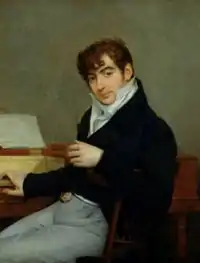Pierre-Joseph-Guillaume Zimmerman
Pierre-Joseph-Guillaume Zimmerman (17 March 1785 – 29 October 1853), known as Pierre Zimmermann and Joseph Zimmermann, was a French pianist, composer, and music teacher.

Biography
Zimmerman was born in Paris, the son of a piano maker.[1] He attended the Paris Conservatory in 1798, studying piano with François-Adrien Boieldieu; while a student there, he won first prizes for piano in 1800 (Friedrich Kalkbrenner came second)[2] and harmony in 1802. He would later study under Luigi Cherubini. Zimmerman became a piano assistant at the Conservatory in 1811 and a full professor there in 1816, serving until 1848; he refused a position as a professor of counterpoint and fugue in 1821. Among his students were Charles Gounod (who married one of his daughters),[2] Georges Bizet, César Franck, Charles-Valentin Alkan, Ambroise Thomas, Louis Lacombe, Alexandre Goria and Lefébure-Wély. In 1842 he denied Conservatory admission to 13-year old Louis Moreau Gottschalk without an audition on account of Gottschalk's American nationality, commenting that "America is a country of steam engines". Zimmerman was often assisted in his teaching by Gounod.
Zimmerman wrote two operas, L'enlèvement (Opéra-Comique, 1830) and Nausicaa (never staged). He also composed two piano concertos, one piano sonata, and numerous other works for piano. His most important legacy is considered his Encyclopédie du pianiste, a complete method of piano playing, including a treatise on harmony and counterpoint.[2]
He died in Paris and is buried in the Auteuil Cemetery in the 16th arrondissement.
His daughter Juliette married Édouard Dubufe.
References
- Slonimsky, Nicolas (1978). "Zimmerman, Pierre-Joseph-Guillaume". Baker's Biographical Dictionary of Musicians (6th ed.). New York: Schirmer Books. p. 1947. ISBN 0-02-870240-9.
- Grove's Dictionary of Music and Musicians, 5th ed., 1951
Sources
%252C_Cimeti%C3%A8re_d'Auteuil%252C_Paris.jpg.webp)
- Don Randel, The Harvard Biographical Dictionary of Music. Harvard, 1996, p. 1010-1011.
External links
- Alkan-Zimmerman International Music Association
- Alkan-Zimmerman International Piano Competition
- Cimetières de France et ailleurs: Cimetière d’Auteuil, brief biography of Zimmerman and photo of his grave